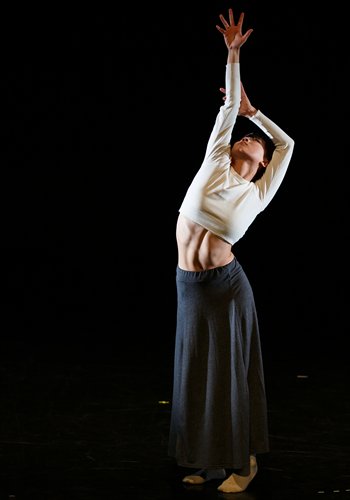Spring Equinox
Well-known choreographer Willy Tsao shares his faith in contemporary Chinese dance

Promotional material for Spring Equinox 2015 featuring Chinese dancer Fan Lu Photo: Courtesy of Willy Tsao
Every time the mass media talks about contemporary dance in China, topics always seem to focus on the negative side: the art form's limited audience, performances that are difficult to understand and hard working dancers struggling to make a living. The last point is especially high profile as even dance celebrities like Jin Xing need to take jobs as TV hosts or judge reality shows to support their dance troupes.
However, Willy Tsao, who many see as the father of contemporary dance in Hong Kong, argues that the media's portrayal of contemporary dance is far from true.
"Slim but healthy, that's contemporary dance's current situation," Tsao told the Global Times.
Natural growth
To celebrate the 10th anniversary of dance troupe Beijing Dance/LDTX, the troupe's dancers have choreographed a series of performances for their fans and themselves.
Spring Equinox 2015 gathers together 14 young artists' personal works, including solos, duets, trios, and group dances. The show, part of the larger Solar Term Series Showcase, is separated into two parts: the first of which premiered over the weekend, while the second is scheduled for this weekend.
For a decade now, the Solar Term Series Showcase has provided a platform for young choreographers to share their ideas and creativity with audiences. Some works that have been performed over the years have been more conceptual while others focused more on experimenting with new possibilities of movement and incorporating different styles into a performance.
The troupe performed to a full house during the weekend's performance. The artistic director for the show, Tsao sat in the back row clapping loudly after every single dance routine.
"I don't know what their (the dancers') futures hold, but at this very moment they proved their drive and dedication to the art," Tsao told the Global Times after the performance.
Tsao numbers among the early artists who brought contemporary dance to Hong Kong and the Chinese mainland. He founded the City Contemporary Dance Company (CCDD) in 1979. Since then, CCDD has created more than 200 original works, toured around the world and cooperated with artists from other art disciplines.
For Tsao, who had been studying overseas, CCDD was about coming back home. According to him, during the 1980s he just went with the flow and as more opportunities opened up in Guangdong Province, Tsao was invited to expand his troupe to the province's capital of Guangzhou. Later during the 1990s, he continued along this path to Beijing where he later established LDTX.
Relax and enjoy
Playing a leading role in the field as well as being a witness to its changes, Tsao has found that the biggest change over the past three decades has been how the environment has evolved from a bureaucratic culture into a market-led culture.
Back in the day, performances all had to be approved by government officials, but later dance troupes suddenly found themselves on their own, having to secure funding and find audiences by themselves.
Audiences also changed. People became so obsessed with money that they could barely stay still for a show. Phones were going off all the time and anything anyone ever talked about was stocks, money, cars and houses. Meanwhile, investors were only concerned with how much money these non-governmental dance troupes could make.
Many troupes weren't used to these changes at first, but over time more non-profit dance organizations like LDTX have found a way to keep up by building long-term relationships with art funds and securing governmental support as well as commercial sponsors. As China's rapid growth began to slow, people also began spending more time thinking about their quality of life and became more willing to spend an hour in a darkened room enjoying a performance.
Not a competition
Every year, Tsao's dance companies organize the Beijing Dance Festival and the Guangzhou Dance Festival, during which they invite artists from different parts of the world to perform and hold workshops in the two cities.
One of his principles has been to never to invite famous brands.
"Famous brands have their own stage at the National Centre for the Performing Arts," he said, going on to explain how Chinese people like to make everything a competition in which they select what they see as the very best. However in Tsao's eyes contemporary dance should be an art that is about differences and diversity. In this art, dance is a mirror that reflects the lives of young dancers and choreographers and therefore every routine is completely unique.
In his opinion, taking in a show isn't so much about whether a performance is good or bad, but more about a person's personal preferences and feelings at the time. People who have just been through a breakup may find content about romantic relationships moving, while people who have an interest in dance may pay more attention to the details of a performance, such as a dancer's movements and poses.
"Hong Kong audiences have seen a lot. They ask why Hong Kong doesn't have a Pina Bausch or a Lin Hwai-min. But I ask 'Why does Hong Kong need a Lin Hwai-min?' and 'Why doesn't Germany have a Helen Lai or Willy Tsao?'" he said, explaining the confidence he has in contemporary Chinese dance.
While he agrees that Pina Bausch deserves her fame because so many people study her and interpret her art, he also feels that people should also be studying and interpreting the works of Chinese artists.
"Beijing is a great place for such research," he said, adding that current and young artists have more to contribute to the development of contemporary dance in China than the study of dance theater or Butoh.
"Tomorrow's masters will come from this current generation. And what they are doing and thinking is what we should be looking at."